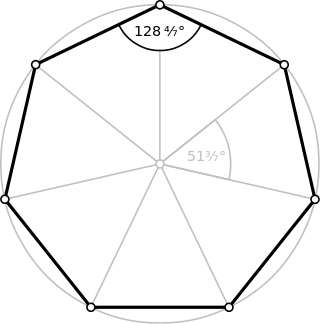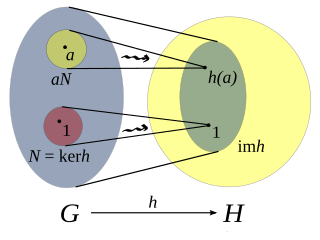Related Research Articles
In mathematics, an associative algebraA over a commutative ring K is a ring A together with a ring homomorphism from K into the center of A. This is thus an algebraic structure with an addition, a multiplication, and a scalar multiplication. The addition and multiplication operations together give A the structure of a ring; the addition and scalar multiplication operations together give A the structure of a module or vector space over K. In this article we will also use the term K-algebra to mean an associative algebra over K. A standard first example of a K-algebra is a ring of square matrices over a commutative ring K, with the usual matrix multiplication.

In mathematics, an abelian group, also called a commutative group, is a group in which the result of applying the group operation to two group elements does not depend on the order in which they are written. That is, the group operation is commutative. With addition as an operation, the integers and the real numbers form abelian groups, and the concept of an abelian group may be viewed as a generalization of these examples. Abelian groups are named after early 19th century mathematician Niels Henrik Abel.

In mathematics, a field is a set on which addition, subtraction, multiplication, and division are defined and behave as the corresponding operations on rational and real numbers. A field is thus a fundamental algebraic structure which is widely used in algebra, number theory, and many other areas of mathematics.

In mathematics, given two groups, (G,∗) and (H, ·), a group homomorphism from (G,∗) to (H, ·) is a function h : G → H such that for all u and v in G it holds that
In algebra, a homomorphism is a structure-preserving map between two algebraic structures of the same type. The word homomorphism comes from the Ancient Greek language: ὁμός meaning "same" and μορφή meaning "form" or "shape". However, the word was apparently introduced to mathematics due to a (mis)translation of German ähnlich meaning "similar" to ὁμός meaning "same". The term "homomorphism" appeared as early as 1892, when it was attributed to the German mathematician Felix Klein (1849–1925).
In mathematics, an identity element or neutral element of a binary operation is an element that leaves unchanged every element when the operation is applied. For example, 0 is an identity element of the addition of real numbers. This concept is used in algebraic structures such as groups and rings. The term identity element is often shortened to identity when there is no possibility of confusion, but the identity implicitly depends on the binary operation it is associated with.
In mathematics, rings are algebraic structures that generalize fields: multiplication need not be commutative and multiplicative inverses need not exist. Informally, a ring is a set equipped with two binary operations satisfying properties analogous to those of addition and multiplication of integers. Ring elements may be numbers such as integers or complex numbers, but they may also be non-numerical objects such as polynomials, square matrices, functions, and power series.
In mathematics, specifically in category theory, a preadditive category is another name for an Ab-category, i.e., a category that is enriched over the category of abelian groups, Ab. That is, an Ab-categoryC is a category such that every hom-set Hom(A,B) in C has the structure of an abelian group, and composition of morphisms is bilinear, in the sense that composition of morphisms distributes over the group operation. In formulas: and where + is the group operation.
In mathematics, the endomorphisms of an abelian group X form a ring. This ring is called the endomorphism ring of X, denoted by End(X); the set of all homomorphisms of X into itself. Addition of endomorphisms arises naturally in a pointwise manner and multiplication via endomorphism composition. Using these operations, the set of endomorphisms of an abelian group forms a (unital) ring, with the zero map as additive identity and the identity map as multiplicative identity.
In mathematics, an algebraic structure consists of a nonempty set A, a collection of operations on A, and a finite set of identities, known as axioms, that these operations must satisfy.
In mathematics, a free abelian group is an abelian group with a basis. Being an abelian group means that it is a set with an addition operation that is associative, commutative, and invertible. A basis, also called an integral basis, is a subset such that every element of the group can be uniquely expressed as an integer combination of finitely many basis elements. For instance the two-dimensional integer lattice forms a free abelian group, with coordinatewise addition as its operation, and with the two points (1,0) and (0,1) as its basis. Free abelian groups have properties which make them similar to vector spaces, and may equivalently be called free-modules, the free modules over the integers. Lattice theory studies free abelian subgroups of real vector spaces. In algebraic topology, free abelian groups are used to define chain groups, and in algebraic geometry they are used to define divisors.

In mathematics, an algebraic group is an algebraic variety endowed with a group structure that is compatible with its structure as an algebraic variety. Thus the study of algebraic groups belongs both to algebraic geometry and group theory.
In mathematics, a module is a generalization of the notion of vector space in which the field of scalars is replaced by a ring. The concept of module also generalizes the notion of abelian group, since the abelian groups are exactly the modules over the ring of integers.
In mathematics, a near-ring is an algebraic structure similar to a ring but satisfying fewer axioms. Near-rings arise naturally from functions on groups.

In mathematics and group theory, the term multiplicative group refers to one of the following concepts:
The direct sum is an operation between structures in abstract algebra, a branch of mathematics. It is defined differently, but analogously, for different kinds of structures. As an example, the direct sum of two abelian groups and is another abelian group consisting of the ordered pairs where and . To add ordered pairs, we define the sum to be ; in other words addition is defined coordinate-wise. For example, the direct sum , where is real coordinate space, is the Cartesian plane, . A similar process can be used to form the direct sum of two vector spaces or two modules.
In mathematics, and more specifically in abstract algebra, a rng is an algebraic structure satisfying the same properties as a ring, but without assuming the existence of a multiplicative identity. The term rng is meant to suggest that it is a ring without i, that is, without the requirement for an identity element.
In mathematics, many types of algebraic structures are studied. Abstract algebra is primarily the study of specific algebraic structures and their properties. Algebraic structures may be viewed in different ways, however the common starting point of algebra texts is that an algebraic object incorporates one or more sets with one or more binary operations or unary operations satisfying a collection of axioms.

In algebra, the zero object of a given algebraic structure is, in the sense explained below, the simplest object of such structure. As a set it is a singleton, and as a magma has a trivial structure, which is also an abelian group. The aforementioned abelian group structure is usually identified as addition, and the only element is called zero, so the object itself is typically denoted as {0}. One often refers to the trivial object since every trivial object is isomorphic to any other.
In mathematics, an exponential field is a field with a further unary operation that is a homomorphism from the field's additive group to its multiplicative group. This generalizes the usual idea of exponentiation on the real numbers, where the base is a chosen positive real number.
References
- ↑ Bourbaki, N. (1998). Algebra I, Chapters 1-3. Springer. p. 98.
- ↑ Natarajan, N. S. (1964). "Rings with generalised distributive laws". J. Indian. Math. Soc. New Series. 28: 1–6.
- ↑ Patterson, Edward M. (1965). "The Jacobson radical of a pseudo-ring". Math. Z. 89 (4): 348–364. doi:10.1007/bf01112167. S2CID 120796340.